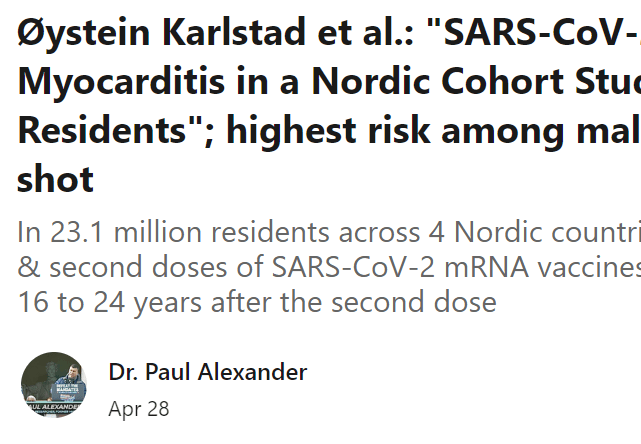COVID Vaccine News: Evidence Shows Higher Risk of Myocarditis in Males 16-24

COVID Vaccine News: Evidence Shows Higher Risk of Myocarditis in Males 16-24
Øystein Karlstad et al.:
“SARS-CoV-2 Vaccination and Myocarditis in a Nordic Cohort Study of 23 Million Residents”; highest risk among males 16-24 yrs after 2nd shot
In 23.1 million residents across 4 Nordic countries, risk of myocarditis after the first & second doses of SARS-CoV-2 mRNA vaccines was highest in young males aged 16 to 24 years after the second dose
SOURCE:
SARS-CoV-2 Vaccination and Myocarditis in a Nordic Cohort Study of 23 Million Residents
“Results Among 23 122 522 Nordic residents (81% vaccinated by study end; 50.2% female), 1077 incident myocarditis events and 1149 incident pericarditis events were identified. Within the 28-day period, for males and females 12 years or older combined who received a homologous schedule, the second dose was associated with higher risk of myocarditis, with adjusted IRRs of 1.75 (95% CI, 1.43-2.14) for BNT162b2 and 6.57 (95% CI, 4.64-9.28) for mRNA-1273. Among males 16 to 24 years of age, adjusted IRRs were 5.31 (95% CI, 3.68-7.68) for a second dose of BNT162b2 and 13.83 (95% CI, 8.08-23.68) for a second dose of mRNA-1273, and numbers of excess events were 5.55 (95% CI, 3.70-7.39) events per 100 000 vaccinees after the second dose of BNT162b2 and 18.39 (9.05-27.72) events per 100 000 vaccinees after the second dose of mRNA-1273. Estimates for pericarditis were similar.
Conclusions and Relevance Results of this large cohort study indicated that both first and second doses of mRNA vaccines were associated with increased risk of myocarditis and pericarditis. For individuals receiving 2 doses of the same vaccine, risk of myocarditis was highest among young males (aged 16-24 years) after the second dose. These findings are compatible with between 4 and 7 excess events in 28 days per 100 000 vaccinees after BNT162b2, and between 9 and 28 excess events per 100 000 vaccinees after mRNA-1273. This risk should be balanced against the benefits of protecting against severe COVID-19 disease.”



